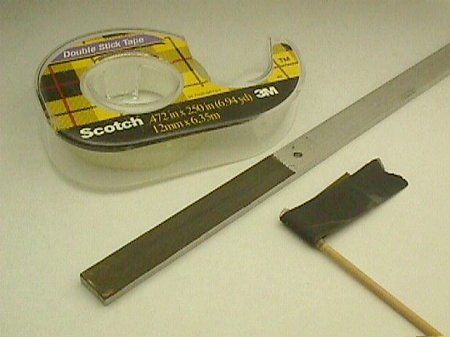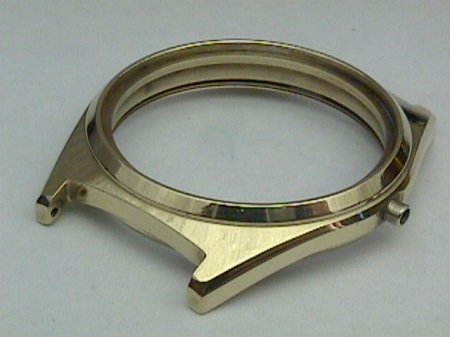 |
Unfortunately, I do not have any "before" pics of the watch, either when I received it or before I removed the original chrome plating. The pic you see here was the one used to advertise the watch, and although it looks quite good, in reality the case was in a poor condition, with many dings and dents, and brass showing through on the lugs and other wear points. The chrome plating was worn off the edges of the crown. Wearing it like this was definitely not an option! |
Restoring (or refinishing, really) a watch case is not as difficult as may be thought, providing major reconstruction is not necessary of course. If the case has broken or bent lugs, big holes or deep scratches that are beyond sanding out, a trip to a jeweller who can do repairs with hard solder is going to be necessary.
You will need to find a "user friendly" plating shop, one which is willing to take on small jobs, and more importantly, work to your instructions. Plating shops usually deal with large items such as plumbing fittings and car parts, so they need to understand that your watch is to go nowhere near their 5 horsepower buffing machine! One touch on that, and your watch will only be half the size it was before!
The materials required are very simple, and are listed here:
- Wet & dry carborundum paper in grits 400, 800 and 1200.
- Double-sided sticky tape, must be the thin type. I use Scotch Double Stick Tape.
- A piece of aluminum or brass flat strip 3mm (1/8") x 10mm (3/8") x 200mm (8")
- A 200mm (8") length of 3mm (1/8") pegwood or dowel
- Some fine metal polish
- A Dremel polishing tool and felt buffs are a great asset, but not necessary.
- A steady hand and a moderate amount of patience!
Before we go any further, we have to make a couple of simple sanding and polishing tools, which will take you no more than 5 minutes to do. This is where the strips, tape and wet & dry paper come into it.
 |
|
Lets get on with it!
Refinishing a case is a 4 step process, I'll take you through them one by one:
Step 1:The original plating has to be removed, and this is done by the plating shop. The plating must be stripped in 2 stages. Most plating, whether chrome, gold or silver, is plated onto a layer of nickel. Firstly, the top plating is removed by "reverse electroplating". The nickel layer is then removed in a cold nickel stripping bath. It is most important not to "plate off" the nickel, as etching of the case will occur, possibly ruining the case. If your shop can't do cold nickel strip, you must find another one which can.
 |
Here we see the case stripped of plating, leaving a brown coloration on the brass base metal. This brown layer rubs off readily, and is a by-product of the nickel strip bath. Use your 400 grit sanding tool to remove the heavy dents and marks, some of which can be readily seen in the pic. Actually, the brown coating makes a nice guide to where attention is needed. Care must be taken at all stages to ensure the original contours of the watch are followed, or rounded-off edges will result. Use slow, steady strokes of your sanding tool, applying only gentle pressure. It is at this stage we would visit our friendly jeweller if serious repairs that require hard-soldering or metal-filling are necessary ie. badly damaged edges or deep holes that require too much metal removal to make right. |
 |
Once the main damage has been removed, repeat the sanding process with your 800 grit tool. This will remove the coarser scratch marks of the 400 grit paper, and the last of the original damage which you are aiming to remove. The pic shows the case after the application of 800 grit paper. We repeat the sanding process again with 1200 grit, which brings the surface finish into the range of being polishable. Again, be careful with your sanding tool and follow the original contours carefully. Do not sand the inside of the watch case. The brown color will be removed in the cleaning baths during re-plating. Remember, once you have moved on to a finer grade of paper, do not use coarser grades again. |
 |
Once you have removed all the unwanted damage, all you should have now is a very smooth finely finished surface. Now it's time for the metal polish. The finished quality of the plating will only be as good as the base metal it is applied to. So, if you want a mirror finish, then it has to be that way before you take the trip to the plating shop. Your Dremel tool will make this part of the job very easy. If you don't have one, then a soft cloth and metal polish works well, as brass polishes quite quickly if you have prepared the surface sufficiently well with your 1200 paper. Wash the polished case in warm soapy water to remove polish residue from gaps and edges, or they won't get plated. |
 |
If your plating shop knows what it's doing, then the watch will come out of the chrome plating bath without requiring any further polishing or attention. All the polishing was done by your good self prior to plating. Just a final rub with a polishing cloth after the watch is reassembled is all that's needed. Complete with a new crystal and a nice quality Zuccolo, Rochet & Cie matching blue leather strap, the watch is looking as good as new! A very pleasing result for relatively little effort and expense. Total time taken: about 2 hours plus 2 trips to the plating shop. Cost: A$30.00 (US$18.00) minimum charge by the plating shop, who would have been happy to have done 3 or 4 for the one minimum charge. |
Other case materials/platings and finishes
Although the above example refers to a chrome-plated watch, the process is exactly the same if you plan on re-plating the watch in gold, silver, rhodium or whatever you like. Just substitute the word "chrome" for the metal of your choice. Many plating shops do hard or soft gold, silver and rhodium as well as chrome, as these metals are often used on trophies etc.
Satin Finishes.To get a satin finish, prepare the watch case with a high polish as described before. Then specify to the plating shop to do satin nickel plate, instead of the normal bright nickel which forms the base layer of the other plated finishes. This is a different plating bath to normal bright nickel, and has chemicals added (or subtracted) to the bath which gives a fine satin finish to the nickel chemically. Then, when the top plating is applied, it will also be satin.
Brushed FinishYou have probably guessed by now that the finished plating quality is only as good as the surface preparation. So, if you want some part of your watch case to have a brushed finish, then this needs to be applied before any plating is done. Prepare and polish all the areas of the watch, including those that you want the brushed finish on. Then, using masking tape, mask off the areas you want to remain polished, then apply the brushed finish. Scotchbrite pads work best for this, but you may want to try different grades of wet and dry paper to achieve the result you want. Experiment on a piece of scrap brass. After brushing, remove the masking tape and clean the case with spirit to remove any adhesive residue. Then very lightly polish the case again with a cloth and metal polish, including the brushed area. Wash the case with warm soapy water to remove polish residues, as before. The final plating will look exactly as the finish you have prepared.
Stainless Steel or Silveroid watch casesAlthough you probably won't even try to plate a case made of these materials (well I hope you don't, because it won't work too well!) you can repair damage to one of these in exactly the same way as preparing a brass watch case for re-plating, only the polishing operations will take a little longer.
Text copyright © 2000 by Rob Berkavicius (Rob B)